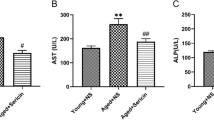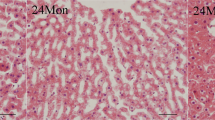Abstract
Background and aims
Aging is associated with a deregulation of biological systems that lead to an increase in oxidative stress, inflammation, and apoptosis, among other effects. Xanthohumol is the main preylated chalcone present in hops (Humulus lupulus L.) whose antioxidant, anti-inflammatory and chemopreventive properties have been shown in recent years. In the present study, the possible protective effects of xanthohumol on liver alterations associated with aging were evaluated.
Methods
Male young and old senescence-accelerated prone mice (SAMP8), aged 2 and 10 months, respectively, were divided into four groups: non-treated young, non-treated old, old treated with 1 mg/kg/day xanthohumol, and old treated with 5 mg/kg/day xanthohumol. Male senescence-accelerated resistant mice (SAMR1) were used as controls. After 30 days of treatment, animals were sacrificed and livers were collected. mRNA (AIF, BAD, BAX, Bcl-2, eNOS, HO-1, IL-1β, NF-κB2, PCNA, sirtuin 1 and TNF-α) and protein expressions (BAD, BAX, AIF, caspase-3, Blc-2, eNOS, iNOS, TNF-α, IL1β, NF-κB2, and IL10) were measured by RT-PCR and Western blotting, respectively. Mean values were analyzed using ANOVA.
Results
A significant increase in mRNA and protein levels of oxidative stress, pro-inflammatory and proliferative markers, as well as pro-apoptotic parameters was shown in old non-treated SAMP8 mice compared to the young SAMP8 group and SAMR1 mice. In general, age-related oxidative stress, inflammation and apoptosis were significantly decreased (p < 0.05) after XN treatment. In most cases, this effect was dose-dependent.
Conclusions
XN was shown to modulate inflammation, apoptosis, and oxidative stress in aged livers, exerting a protective effect in hepatic alterations.






Similar content being viewed by others
References
Sanz A, Stefanatos RK (2008) The mitochondrial free radical theory of aging: a critical view. Curr Aging Sci 1(1):10–21
Schmucker D (2005) Age-related changes in liver structure and function: implications for disease? Exp Gerontol 40(8–9):650–659
Preedy V (2014) Aging. Chapter 1. Oxidative stress and frailty: a closer look at the origin of a human aging phenotype
Aikata H, Takaishi H, Kawakami Y, Takahashi S, Kitamoto M, Nakanishi T et al (2000) Telomere reduction in human liver tissues with age and chronic inflammation. Exp Cell Res 256(2):578–582
Jaskelioff M, Muller F, Paik J, Thomas E, Jiang S, Adams A, Sahin E, Kost-Alimova M, Protopopov A, Cadiñanos J, Horner J, Maratos-Flier E, DePinho R (2010) Telomerase reactivation reverses tissue degeneration in aged telomerase-deficient mice. Nature 469(7328):102–106
Aravinthan A, Alexander G (2016) Senescence in chronic liver disease: is the future in ageing? J Hepatol 65:825–834
Pinto C, Cestero J, Rodríguez-Galdón B, Macías P (2014) Xanthohumol, a prenylated flavonoid from hops (Humulus lupulus L.), protects rat tissues against oxidative damage after acute ethanol administration. Toxicol Rep 1:726–733
Vanhoecke B, Derycke L, Van Marck V, Depypere H, De Keukeleire D, Bracke M (2005) Antiinvasive effect of xanthohumol, a prenylated chalcone present in hops (Humulus lupulus L.) and beer. Int J Cancer 117(6):889–895
Zhang B, Chu W, Wei P, Liu Y, Wei T (2015) Xanthohumol induces generation of reactive oxygen species and triggers apoptosis through inhibition of mitochondrial electron transfer chain complex I. Free Radical Biol Med 89:486–497
Ungvari Z, Kaley G, de Cabo R, Sonntag WE, Csiszar A (2010) Mechanisms of vascular aging: new perspectives. J Gerontol Ser A Biol Sci Med Sci 65(10):1028–1041
Takeda T, Hosokawa M, Takeshita S, Irino M, Higuchi K, Matsushita T et al (1981) A new murine model of accelerated senescence. Mech Ageing Dev 17(2):183–194
Yagi H, Katoh S, Akiguchi I, Takeda T (1988) Age-related deterioration of ability of acquisition in memory and learning in senescence accelerated mouse: SAM-P/8 as an animal model of disturbances in recent memory. Brain Res 474(1):86–93
Tresguerres JA, Kireev R, Forman K, Cuesta S, Tresguerres AF, Vara E (2012) Effect of chronic melatonin administration on several physiological parameters from old wistar rats and SAMP8 mice. Curr Aging Sci 5(3):242–253
Paredes SD, Forman KA, Garcia C, Vara E, Escames G, Tresguerres JA (2014) Protective actions of melatonin and growth hormone on the aged cardiovascular system. Hormone Mol Biol Clin Investig 18(2):79–88
Puig A, Rancan L, Paredes SD, Carrasco A, Escames G, Vara E et al (2016) Melatonin decreases the expression of inflammation and apoptosis markers in the lung of a senescence-accelerated mice model. Exp Gerontol 75:1–7
Rancan L, Paredes SD, García I, Muñoz P, García C, López de Hontanar G, de la Fuente M, Vara E, Tresguerres JAF (2017) Protective effect of xanthohumol against age-related brain damage. J Nutr Biochem 49:133–140
Montoliu C, Vallés S, Renau-Piqueras J, Guerri C (2002) Ethanol-induced oxygen radical formation and lipid peroxidation in rat brain: effect of chronic alcohol consumption. J Neurochem 63(5):1855–1862
Chomcznyski P, Sacchi N (2006) The single-step method of RNA isolation by acid guanidinium thiocynate-phenol-chloroform extraction: twenty something years on. Nat Protoc 1:581–585
Shmittgen DT, Livak KJ (2001) Analysis of relative gene expression data using real-time quantitive PCR and the 2-∆∆CT method. Methods 25:402–408
Pasparakis M, Alexopoulou L, Episkopou V, Kollias G (1996) Immune and inflammatory responses in TNF alpha-deficient mice: a critical requirement for TNF alpha in the formation of primary B cell follicles, follicular dendritic cell networks and germinal centers, and in the maturation of the humoral immune response. J Exp Med 184(4):1397–1411
Lee IS, Lim J, Gal J, Kang JC, Kim HJ, Kang BY et al (2011) Anti-inflammatory activity of xanthohumol involves heme oxygenase-1 induction via NRF2-ARE signaling in microglial BV2 cells. Neurochem Int 58(2):153–160
Gieling R, Wallace K, Han Y (2009) Interleukin-1 participates in the progression from liver injury to fibrosis. Am J Physiol Gastrointest Liver Physiol 296(6):G1324-G1331
Tak P, Firestein G (2001) NF-κB: a key role in inflammatory diseases. J Clin Investig 107(1):7–11
Peluso I, Raguzzini A, Serafini M (2013) Effect of flavonoids on circulating levels of TNF-alpha and IL-6 in humans: a systematic review and meta-analysis. Mol Nutr Food Res 57(5):784–801
Garcia-Lafuente A, Guillamon E, Villares A, Rostagno MA, Martinez JA (2009) Flavonoids as anti-inflammatory agents: implications in cancer and cardiovascular disease. Inflamm Res 58(9):537–552
Paredes SD, Rancan L, Kireev R, González A, Louzao P, González P, Rodríguez-Bobada C, García C, Vara E, Tresguerres J (2015) Melatonin counteracts at a transcriptional level the inflammatory and apoptotic response secondary to ischemic brain injury induced by middle cerebral artery blockade in aging rats. BioRes Open Access 4(1):407–416
Meador BM, Krzyszton CP, Johnson RW, Huey KA (2008) Effects of IL-10 and age on IL-6, IL-1beta, and TNF-alpha responses in mouse skeletal and cardiac muscle to an acute inflammatory insult. J Appl Physiol 104(4):991–997
Lu B, Chen H, Lu HG (2012) The relationship between apoptosis and aging. Adv Biosci Biotechnol 3:705–711
Daugas E, Nochy D, Ravagnan L, Loeffler M, Susin SA, Zamzami N et al (2000) Apoptosis-inducing factor (AIF): a ubiquitous mitochondrial oxidoreductase involved in apoptosis. FEBS Lett 476(3):118–123
Cau SB, Carneiro FS, Tostes RC (2012) Differential modulation of nitric oxide synthases in aging: therapeutic opportunities. Front Physiol 3:218
Schipper HM (2000) Heme oxygenase-1: role in brain aging and neurodegeneration. Exp Gerontol 35(6–7):821–830
Kelman Z (1997) PCNA: structure, functions and interactions. Oncogene 14(6):629–640
Guarente L (2007) Sirtuins in aging and disease. Cold Spring Harb Symp Quant Biol:483–488
Acknowledgements
The authors would like to thank Medicine students Paula Corral, Bryan Hyacinthe, and Mario Calvo-Soto (School of Medicine, Complutense University of Madrid, Spain) for their continued interest and cooperation in our work. The skillful technical assistance of Rocío Campón (Dept. of Physiology, School of Medicine, Complutense University of Madrid, Spain) is also gratefully acknowledged.
Funding
This study was supported by Grants from Red de Fragilidad y Envejecimiento RETICEF (RD12/0043/0032) and GRUPOS UCM-BSCH (GR35/10-A).
Author information
Authors and Affiliations
Contributions
EV, JAFT designed the research; CFG, LR, SDP, CM conducted the research; EV, MF analyzed the data; CFG, LR, SDP, EV wrote the paper. All authors read and approved the final manuscript.
Corresponding author
Ethics declarations
Conflict of interest
The authors declare no conflict of interest.
Additional information
Elena Vara and Jesús A. F. Tresguerres share senior authorship.
Rights and permissions
About this article
Cite this article
Fernández-García, C., Rancan, L., Paredes, S.D. et al. Xanthohumol exerts protective effects in liver alterations associated with aging. Eur J Nutr 58, 653–663 (2019). https://doi.org/10.1007/s00394-018-1657-6
Received:
Accepted:
Published:
Issue Date:
DOI: https://doi.org/10.1007/s00394-018-1657-6




